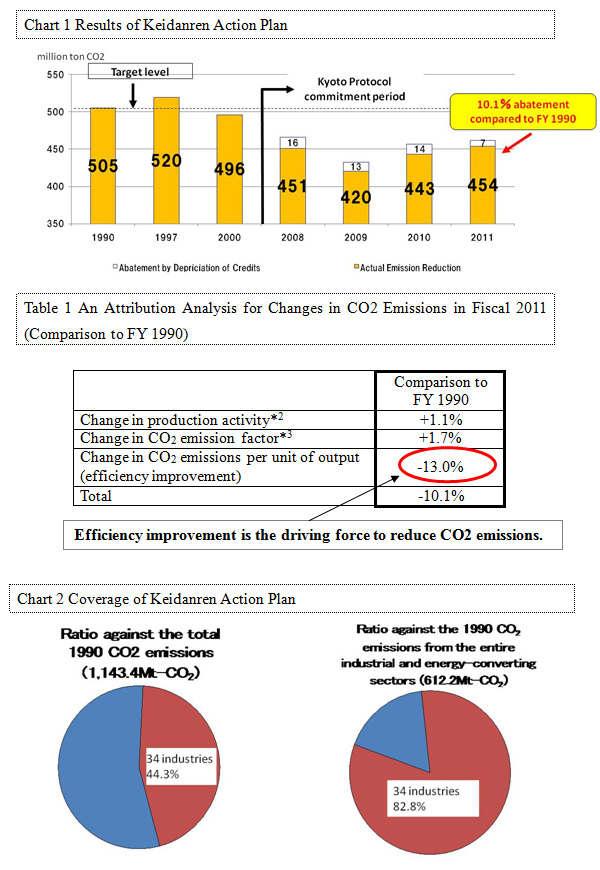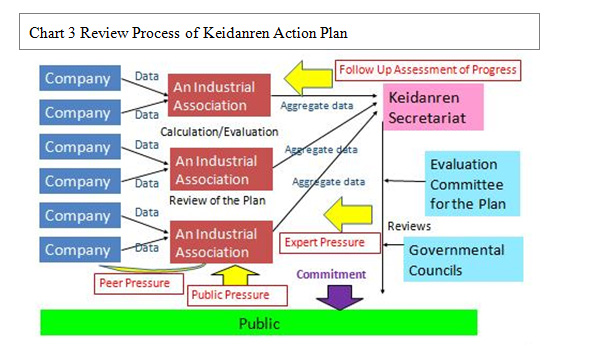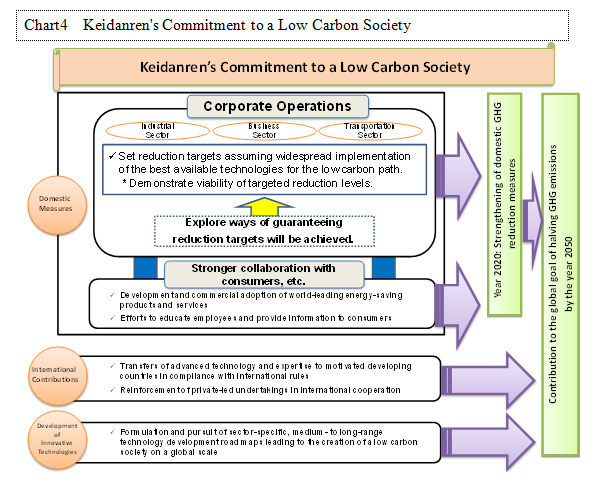Keidanren
1. Introduction
As an issue shared by humanity as a whole, global warming should be addressed from a long-term perspective and requires all countries to act responsibly.
However, since UN climate change negotiations over the past 20 years took a top-down approach to setting greenhouse gas (GHG) emission reduction targets, they were not successful in expanding the number of countries prepared to commit to reducing emissions. As a result, although the Kyoto Protocol was a significant first step towards addressing global warming, world GHG emissions could not be brought under control even after it came into force.
Meanwhile, the latest UN negotiations concerning a future framework to apply from 2020 have seen growing support for a bottom-up approach, whereby each country decides its own targets and actions and these are reviewed internationally. This mechanism is highly effective in encouraging responsible participation by all countries.
The Japanese business community has steadily achieved reductions in actual domestic emissions through a bottom-up action plan rather than top-down systems such as emission trading schemes (see charts 1, 2 and table 1). At the same time, it has greatly contributed to the development and spread of energy-saving and low-carbon technologies. Moreover, it has made advances in effective cooperation and information exchange among companies.
Based on these experiences, Keidanren will submit the following proposal to the 19th session of the Conference of the Parties (COP 19) to the United Nations Framework Convention on Climate Change as an aid to international discussion of a framework for 2020 and beyond.
2. Japanese Industry Initiatives
(1) Importance of PDCA Cycle
Although bottom-up approaches are highly effective, they present issues regarding credibility and transparency, such as devising methods for eliciting the maximum targets from each player and ensuring that they are achieved. The plan-do-check-act (PDCA) cycle operated as part of Keidanren's Action Plan offers useful pointers for addressing these issues (see chart 3).
- In addition to setting technology-backed reduction targets on the premise that installation of best available technologies (BAT) will be maximised when constructing or upgrading facilities, participating industries accept accountability for the appropriateness of their own targets.
- Progress towards achievement of participating industries' targets and plans is verified within and across industries, and evaluated and verified by a third-party evaluation committee and government councils.
- Participating industries revise their plans as required based on the results of a series of reviews. So far 39 industries in total have raised their own target levels as achievement of original targets has become likely.
(2) Towards Long-Term Global Reductions
Keidanren's Action Plan concluded in fiscal 2012 with the end of the Kyoto Protocol First Commitment Period, but rather than leaving a hiatus from fiscal 2013, the Japanese business community has launched new efforts through Keidanren's Commitment to a Low Carbon Society.
Based on a vision for Japanese companies to share in the international community's goal of halving GHG emissions by 2050 and contribute to its realisation by harnessing technology, this plan sets out specific efforts to achieve a low-carbon society worldwide. In addition to the original objective of domestic emission reductions (including reductions over the entire life cycle of products and services), the plan comprises the two additional objectives of making international contributions (to overseas reductions) and developing innovative technologies (see chart 4).
3. Suggestions for a Future Framework
(1) Pledge and Review Framework
A bottom-up approach, whereby each country formulates appropriate targets and actions based on its own economic circumstances, will be effective in encouraging all countries to act with a view to reducing worldwide GHG emissions. From the perspective of ensuring credibility and transparency, it will be possible to further encourage each country to make maximum effort by making it accountable for achieving its own targets and actions and internationally reviewing progress towards such goals.
Moreover, international efforts to share best practices in fields including energy conservation measures and low-carbon technologies will also be effective in promoting emission reductions.
(2) Nature of Targets and Actions
Since the scope for further emission reductions within Japan is limited by the significant progress already made with global warming countermeasures, Keidanren's Commitment to a Low Carbon Society sets a clear direction focusing not only on domestic reductions (including reductions over the entire life cycle of products and services), but also development of innovative technologies and international contributions through the overseas transfer of technologies, products, and expertise.
To encourage long-term reductions on a global scale, the framework for 2020 and beyond should promote specific actions such as international contributions and innovative technology development in addition to domestic reduction targets.
The various approaches currently being discussed by the UN are important in this regard. For example, country-specific schemes for technology transfer from developed countries to emerging and developing nations, such as the bilateral offset mechanism being advanced by Japan, are expected to lead to actual emission reductions on a global scale.
In addition to mitigation, mechanisms for internationally evaluating support for adaptation of technologies to developing countries will be vital in encouraging the development and widespread use of adaptive technologies.
(3) Creating an Environment Conducive to Comprehensive International Review
Determining a common format to facilitate comparative verification and submitting data (including international comparisons of energy efficiency for individual industries) useful for evaluations by specialised agencies such as the International Energy Agency will be effective in conducting international reviews of each country's targets and actions.
(4) Creating an Environment Conducive to Development and Widespread Use of Energy-Saving/Low-Carbon Technologies and Products
The widespread deployment of energy-saving and low-carbon technologies and products on a business basis will drive emission reductions on a global scale while achieving both environmental and economic goals. To this end, it will be necessary to reinforce international efforts to eliminate barriers to trade in environmental goods while also constructing mechanisms to encourage technology transfer to developing countries on the premise of effective protection of intellectual property.
Government assistance is also anticipated to aid the spread of energy-saving and low-carbon technologies and products that entail high costs. The organic interlinking of finance and technology mechanisms currently being designed by the UN will be crucial to creating an environment that encourages global deployment of technology.
4. Conclusion
Through Keidanren's Commitment to a Low Carbon Society, we will not only reduce domestic emissions, but also actively work to support developing countries, develop innovative technologies, and continue contributing to GHG reduction on a global scale.
At the same time, we will use COP 19 and similar meetings as forums for proactively sharing information on the experiences and views of the Japanese business community, in the aim of building truly effective international framework for the future.




